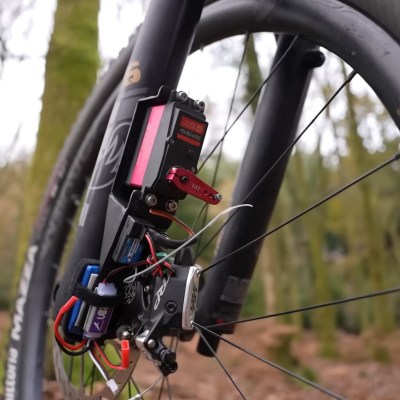Bicycles are the most efficient machines for moving a person around, and wireless drivetrains have been heralded as a way to make shifting more consistent and require less maintenance. [Blake Samson] wondered if the same could be true of wireless brakes.
 Inspired by the controller for an RC car, [Blake] picked a 150 kg servo attached to a cable-actuated hydraulic disc caliper to apply the braking force. The servo, receiver, power stabilizer, and batteries were all mounted on a custom steel plate fabricated to mount under the caliper. [Blake] cut up an old set of mountain bike brake levers to reuse the handlebar mounts and then put the batteries, controller, and finger triggers on them.
Inspired by the controller for an RC car, [Blake] picked a 150 kg servo attached to a cable-actuated hydraulic disc caliper to apply the braking force. The servo, receiver, power stabilizer, and batteries were all mounted on a custom steel plate fabricated to mount under the caliper. [Blake] cut up an old set of mountain bike brake levers to reuse the handlebar mounts and then put the batteries, controller, and finger triggers on them.
Confident in his hacking skills, [Blake] then took the bike out on some trails to test the brakes. As a prototype, there were a few surprises along the way, like one of the triggers staying locked in the braking position, but they performed admirably enough that he’s mulling over a Mk. 2.
Bikes are one of our favorite hacking platforms. Be sure to checkout this dreamy cargo bike build, an awesome bike camper, or what can happen if your bike is dependent on the cloud to work.
Continue reading “Wireless Bike Brakes” →




 Inspired by the controller for an RC car, [Blake] picked a 150 kg servo attached to a cable-actuated hydraulic disc caliper to apply the braking force. The servo, receiver, power stabilizer, and batteries were all mounted on a custom steel plate fabricated to mount under the caliper. [Blake] cut up an old set of mountain bike brake levers to reuse the handlebar mounts and then put the batteries, controller, and finger triggers on them.
Inspired by the controller for an RC car, [Blake] picked a 150 kg servo attached to a cable-actuated hydraulic disc caliper to apply the braking force. The servo, receiver, power stabilizer, and batteries were all mounted on a custom steel plate fabricated to mount under the caliper. [Blake] cut up an old set of mountain bike brake levers to reuse the handlebar mounts and then put the batteries, controller, and finger triggers on them.












